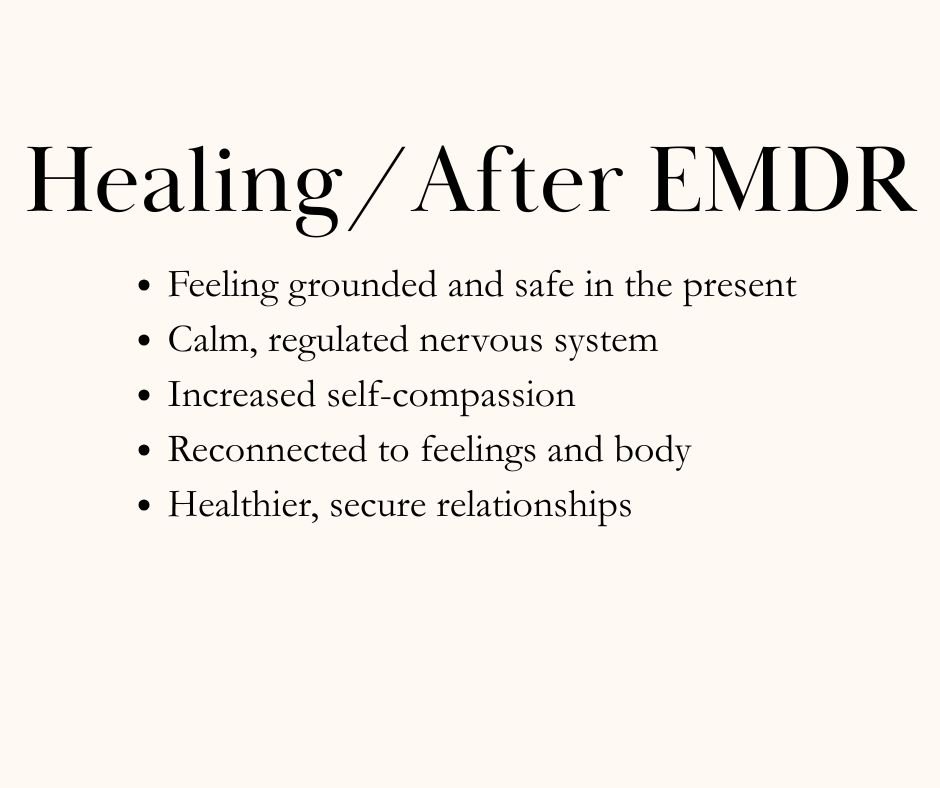
EMDR Therapy
What is EMDR Therapy?
EMDR stands for eye movement desensitization and reprocessing. It uses bilateral stimulations, including eye movements, sound stimulations, and tapping to help all parts of the brain and body to process emotions, thoughts, and traumatic events.
How EMDR Works?
Trauma can overwhelm the brain’s natural ability to process experiences, leaving memories "frozen" in the nervous system. These unprocessed memories can continue to trigger distressing emotions, body sensations, and beliefs long after the event has passed. EMDR helps activate the brain’s innate healing mechanisms using bilateral stimulation—typically eye movements, tapping, or sound—to support the reprocessing of traumatic or overwhelming experiences. As these memories are reprocessed, the emotional intensity decreases, and new, more adaptive beliefs can take root.
The Phases of EMDR Therapy
EMDR therapy follows an eight-phase protocol:
History Taking & Treatment Planning – We explore your background, current challenges, and identify target memories to work on.
Preparation – You’ll learn calming tools and resources to help you feel safe and grounded throughout the process.
Assessment – We identify the specific memory, related beliefs, emotions, and body sensations to target during reprocessing.
Desensitization – Using bilateral stimulation, we begin reprocessing the memory, reducing its emotional intensity.
Installation – We strengthen new, more adaptive beliefs to replace old negative ones.
Body Scan – We check for and release any lingering distress in the body.
Closure – We ensure you feel safe, stable, and grounded at the end of each session.
Reevaluation – In follow-up, we assess the progress and identify any remaining areas needing attention.
Together, these phases guide your healing journey in a structured, compassionate, and effective way—whether you're doing a short-term intensive or longer-term therapy.
Why EMDR Therapy?
Most of the clients whom I work with, know how to think rationally. They just don't know why they are still feeling or stuck feeling a certain way. They know there are things they should let go of, but they keep on having intrusive thoughts and memories. This is when EMDR can help to bridge the gap.
Sometimes, when EMDR therapy is not working, it maybe protective mechanism at work. If that's the case, integrated with IFS therapy and Somatic Experiencing can help support those protective parts of us. In therapy, we will encounter many choice points of where to go next, and I will always pause and check in with you to make sure you are getting what you need in the therapy session.
Can we do EMDR online?
Yes, I used a soft way where clients can follow the dots for eye movement or listen to the sound of bilateral stimulations. All you need is a computer, a good set of earbuds/headphones, a good internet connection, and a place where you can talk privately.
How EMDR Can Help with
Childhood Trauma
EMDR helps process and integrate painful childhood memories that fuel CPTSD symptoms. By safely reprocessing these experiences, clients often notice reduced triggers, calmer nervous system responses, and greater emotional resilience—making space for self-compassion, connection, and healing.
“EMDR therapy targets the unprocessed memories that contain the negative emotions, sensations and beliefs. By activating the brain’s information processing system (which will be explained in Chapter 2), the old memories can then be “digested.” Meaning what is useful is learned, what’s useless is discarded, and the memory is now stored in a way that is no longer damaging.”
— Francine Shapiro, “Getting Past Your Past: Take Control of Your Life with Self-Help Techniques from EMDR Therapy
Virtual
Lynnwood WA
Hybrid









